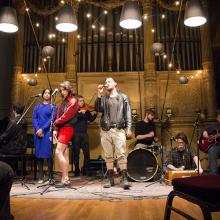artist
Cypriot artist George Gavriel almost lost his job as a high school headmaster after his works depicting Jesus in unconventional settings and also taking a swipe at politicians drew the wrath of religious and government leaders.
Gavriel, 62, uses his art as a protest medium to take aim at what he considers the ills of society.

Abhay Singh & Friends performs during Arts Wednesdays at Judson Memorial Church. Photo via Judson Memorial Church / RNS
On the north side of Indianapolis, the historic First Presbyterian Church is now the Harrison Center for the Arts. Its owner, the upstart Redeemer Presbyterian Church, is landlord to two dozen artist studios, three apartments, four galleries, an annual music festival, and the Indiana office of VSA, the John F. Kennedy Center’s nationwide arts program for people with disabilities.
Redeemer is among a host of churches that own old buildings and have embraced the arts as a way of enlivening hallowed spaces, breaking down barriers with neighbors, and paying the heating bills.
On the second Sunday of Lent, John Hendrix sits in one of the pews near the back of Grace and Peace Fellowship, a Presbyterian church with stained glass in green and orange, and a giant, organ pipe front and center.
Casually decked in a striped, button-down shirt and jeans, he looks like any other member of the hip and young crowd. With his wife, Andrea, and his two children, Jack, 8, and Annie, 5, Hendrix stands and sings and partakes of gluten-free communion.
But as soon as the sermon starts, Hendrix sets himself apart, whipping out his sketchbook and pens to draw the pastor’s sermon.
ONE RECENT WINTER day, Nora Howell stepped out of her house in the Sandtown neighborhood of Baltimore and took a walk down the street. People in the predominantly black community did double takes as this white woman promenaded past them in a sundress made of saltine and oyster crackers. Some stared in disbelief. One man doubled over laughing. In the corner coffee shop, one of the regulars warned Howell not to walk by any homeless people because they might just eat her up.
Later Howell, a community artist and director of the neighborhood Jubilee Arts program, set the video footage taken during her walk to Mister Rogers’ classic refrain, “Won’t You Be My Neighbor?” The piece, which emerged out of Howell’s ponderings on what it means to be white living in a black neighborhood, became another part of her answer to a call: to use art to address systemic racism and bring about the kingdom of God.
From Race Riots to White Suburbia and Beyond
In 2001, Howell was an eighth grader living in a biracial community in urban Cincinnati. When race riots erupted after a young black man was shot fatally by a white police officer (sound familiar?), her family took to the streets on a prayer walk through the riots. Howell remembers being shocked and terrified, thinking, “Why do we still have race riots? Cincinnati is so far behind the times.”
In the aftermath, Howell talked with peers at school on the reality of racial tensions and observed with curiosity how white and black churches throughout the city responded. She realized race riots weren’t just a relic of the ’60s. “When you lived in a place where different racial groups interacted daily, [racial tensions] could no longer be denied or ignored,” she said.
Yet when Howell moved to suburban Chicago to attend Wheaton College, conversations on race were largely absent. “I found that very odd,” she said. She got involved in a campus group to promote awareness of racial injustice.

Screenshot of post on Carrie Underwood's Instagram feed. Photo courtesy http://instagram.com/.
The notion of God as an artist is hardly new. In the Middle Ages, the concept of a divine artist, or architect, was often invoked. The biblical artists Bezalel and Oholiab are described as being “full of the spirit of God.” In Catholic art, angels often guide St. Luke’s hand when he draws the Virgin.
But when Twitter and Pinterest users take to their smartphones to snap pictures of sunrises and sunsets and attribute those “masterpieces” to God, they are exhibiting a new sort of adoration.
LAUGHTER IS Sacred Space: The Not-So-Typical Journey of a Mennonite Actor has the narrative arc of a classic Greek tragedy: Boy from religious sect grows up, becomes a butcher, goes to seminary, then finds acting acclaim as part of a duo (Ted & Lee), only to have his comedic partner die by suicide, after which the show must go on and does.
Ted Swartz’s story is a bittersweet tale, with emphasis on the sweet. It is told in the structure of a five-act play. What originally drew me was the fact that Swartz’s late acting partner, Lee Eshleman, was a classmate of mine at Eastern Mennonite University, where we were art majors to-gether. Eshleman was easily the most talented among us. (His line drawings illustrate the book.) He was also smart, funny, and regal.
After I left EMU, unmarried and pregnant, I would sometimes see Eshleman’s name on the masthead of the alumni magazine and think, “I wish I had it as together as Lee does.” It was a shock to hear that, like my own son, Eshleman too had died by suicide.
His death and its impact on Swartz take up a good deal of space in this memoir. The duo worked together for 20 years, and Swartz is honest about the ups and downs of their friendship. He does a great job of communicating that Eshleman was much more than his suicide or his bipolar disorder. He was that extraordinary person I remember.
IF YOU ARE not overly familiar with the repertoire of a Leonard Cohen concert, it's hard to tell the new songs from the old. Songs from a different age sound neither anachronistic nor nostalgic, while the new echo as though they have been around forever. It's the same show night after night, with songs from the latest album, Old Ideas (released in 2012), woven into the familiar canon. Cohen tells audiences that his revivalist tour might end in two years, so that he can start smoking again by the time he turns 80.
It is a joke you know Cohen has cracked a hundred times, the kind that makes my brother call him the Jewish Dean Martin. The humor is one part of a precise choreography, whose arrangements shift from blues to waltzes to New Orleans jazz, Celtic, gospel, country, and disco, all set in the mode of Hebrew Minor and conspiring to create a vivid world that does not exist, except in paradox. Honey is the texture that comes to mind. Viscous and turbid, neither solid nor liquid. Sensual relief from the coarse, metallic world. And sweet. Sweet in the meaning of the verse from the Persian song "Navaee"—"High sweet melody, and sadness of love, dwelling in the bottom of the heart, where nobody sees"—the mixing of sorrow and transcendence into sublime paradox.
He is and has been many things to his devotees: poet, singer, writer, band leader, lover, satirist, artist, and novelist. But one thing Leonard Cohen is not is a preacher.
Prostrating and posing on bended knee, eyes knit tight, hat pulled low—he could say anything he pleases, from treatises to treason, and people would listen. Given a room and a crowd, the born preachers cannot tame the urge to climb atop the pulpit. This political instinct to prophesy and govern is noted but subdued in the opening song of Old Ideas, called "Going Home," the cry of an old man liberated from burdens of desire for love and for mission: "He will speak these words of wisdom / like a sage, a man of vision / though he knows he's really nothing / but the brief elaboration of a tube ... a lazy bastard living in a suit."
“What I do every day is get a pencil, take a piece of paper, and draw,” Wes Noyes said.
The 17-year-old artist hopes someday to work in animation or as a graphic artist. Wes works for more than an hour a day, takes classes, and to date has made more than 500 pencil drawings.
After Wes playfully collaborated on a chalk drawing made by his mother Rebekah Greer, his work as a cartoonist gained national attention.
Greer, a photographer, musician, and the mother of five, had drawn fanciful backgrounds — a cityscape, an ocean scene among them — on the family’s driveway one evening this past summer and took portraits of her children posing in front of them. Wes added to the drawing she had made for son Jonah, then eight, by adding flames and interjecting himself into the picture as Godzilla.
When Greer posted the photo to Facebook, it quickly went viral.
“It sort of spread around,” Wes said simply.
The picture, titled “Brother of the Year,” has indeed “spread around.”

“The practice of peace and reconciliation is one of the most vital and artistic of human actions.” — Vietnamese Buddhist monk Thich Nhat Hanh
How do you combat violence, institutionalized rape, a corrupt government, and years of injustice? With more violence, better weapons, or more strategic strikes?
For Petna Ndaliko, you do it through art. In spite of attempts by the Congolese government and militia groups to silence them, Petna created a stage for local youth to express themselves. They sing about oppression, about corruption, and about the people’s ability to overcome.
Art heals. It unites a community. And it can ignite a spark for change. Film can inspire rape survivors to find their voices and tell their stories. From a grassroots level, music moves people to action.
Petna calls himself a small light from which a huge fire starts growing. For many Christians, this echoes Matthew 5:14, “You are the light of the world. A city built on a hill cannot be hidden.”
Petna’s hope is for the flame to spread through the youth of Congo, to carry the message of hope forward to future generations, finding creative ways to combat injustice.
WHENEVER I entered a museum gallery and saw sculptures by Elizabeth Catlett, I wanted to touch them. The figures were often smooth, glistening, and engaging. They spoke to me in the same manner as the poetry of Langston Hughes and the musical compositions of Duke Ellington.
When Catlett died in April, I was reminded again that she created artwork for celebration and spiritual nourishment. She mastered the ability to bring beauty out of wood and stone.
In many ways Catlett was ahead of her times. During the 1940s she had explored the black woman’s body as a theme for sculpture and paintings. The images she created upheld the strength and dignity of women. The black woman presented as mother could be seen nurturing a child. In work such as “Homage to My Young Black Sisters,” the black woman figure strikes a posture of resistance with a fist raised. The buttocks of the cedar sculpture reflect strength as well as sensuality. One is quickly reminded of young Student Nonviolent Coordinating Committee workers, members of the Black Panther Party, and even activist Angela Davis. “Homage to My Young Black Sisters” was created in 1968, the same year the Summer Olympics in Mexico City saw track stars John Carlos and Tommie Smith raise their fists on the awards stand in a black power salute.
The art of Elizabeth Catlett ignored borders. Although she resided in Mexico, her work reflected the changing consciousness of African Americans in the 1960s and 1970s. The civil rights and black power movements renewed interest in African-American history. The black art movement introduced a desire to define a black aesthetic. Catlett’s work as an elder provided younger artists with a model and a teacher to emulate. In 1969, she created the print “Malcolm X Speaks for Us.” In it we see how she links Malcolm’s face to that of other black faces. The result is a powerful sense of community.

Sister Corita Kent. Image via www.corita.org.
Bright bold text danced across expansive white-framed serigraphs lining our college student center. The first moment I set foot on my college campus, Westmont College in Santa Barbara, Calif., the artwork of Sister Mary Corita Kent captured my heart and imagination.
One playful print, about the bread of life, features the signature bold red yellow and blue Wonder Bread wrapper.
Another featured Beatles lyrics: “I get by with a little help from my friends.”
One, playing on the name of the West Coast grocery chain “SafeWay,” points to the One who called himself “the Way.”
Another — the commentary of one Roman Catholic upon another?— employed Scripture to reference JFK: “There was a man sent from God whose name was John.”
Yet another, in patriotic red, white and blue, features the words of Camus, “I should like to be able to love my country and still love justice.”
At 18, not yet knowing myself to be called as a bearer of color and words and truth, my voice was unleashed by the prophetic artwork of Sister Corita.
 ++ Join us in showing our appreciation for Catholic women religious (aka nuns or "sisters") on Thank-a-Nun Day, May 9. Click HERE to send a thank-you note online. ++
++ Join us in showing our appreciation for Catholic women religious (aka nuns or "sisters") on Thank-a-Nun Day, May 9. Click HERE to send a thank-you note online. ++

Makoto Fujimura via www.makotofujimura.com
Why I’m not an evangelical … and why I am:
“Evangelical” is a dirty word in the New York art world. A friend, an artist, told me that before she understood the claims of the Bible, she thought Christianity was a weird political group, and evangelicals the most extreme and terrifying. Whenever this word is raised, the next statement is “oh no, you are not one of them, are you?!”
Then, I usually say,“well, it depends on what you mean by the word ‘evangelical,’” followed by a confession, “I am not sure if I am an evangelical but let’s do talk about what the word actually means.”
People often assume that I am of the evangelical persuasion because I have been associated with many churches and Christian organizations. I just completed a major project for the 400th Anniversary of King James Bible. I was even appointed by President George W. Bush to the National Council on the Arts. People in the art world assume that if you have anything to do with President Bush and the Bible then you must be an evangelical.





